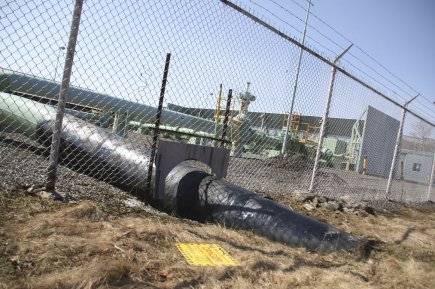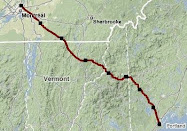Tar sands oil heading east? Controversial crude could make its way to New England via pipeline
DOVER — The Keystone XL pipeline extension, which would transport an oil product known as "tar sands" to refineries on the Gulf Coast, has received a wealth of media attention this year.
However, the Keystone XL pipeline isn't the only transportation path for tar sands oil. Oil suppliers have explored a number of ways to move the controversial petroleum product to market, including pathways through the Northeast.
One of Canada's largest pipeline operators, Enbridge, Inc., developed a plan in 2008 to reverse one of its existing lines to begin moving tar sands oil east from Western Canada, where the industry is set to boom.
Enbridge's Line 9, which starts in the western part of the country, would be capable of delivering tar sands oil to Montreal if the company reversed the flow of the entire line.
Enbridge proposed doing just that four years ago with it's so-called "Trailbreaker" project.
To move the tar sands oil on the final leg of the journey from Montreal to Maine, the company proposed utilizing the existing Portland-Montreal Pipe Line.
PMPL stretches more than 200 miles, cutting through Vermont and northern New Hampshire. It currently transports crude in the other direction, from Maine to Montreal.
Enbridge officials have since scrapped the Trailbreaker project, citing a sour economy. But environmental groups in both Canada and the United States believe recent actions indicate the company is working to revive the proposal incrementally.
Recently, Enbridge filed a request with Canada's National Energy Board to reverse the flow of oil in a segment of Line 9, which connects Sarnia and Westover in Ontario.
Enbridge spokesperson Jennifer Varey said the company is making the move in order to begin transporting light crude to a facility in Westover.
Varey said Line 9's future use will be dictated by the demands of shippers, and Enbridge has not determined whether to request permission from Canadian officials to reverse the entire pipeline.
"It's one of those things where, if the market demand is there, there is the possibility that we would be bringing Canadian oil to those markets," in the Northeast, she said.
In addition to the activity around Line 9, environmental groups in Canada have been following developments near Montreal, where the operator of the Portland-Montreal Pipeline is seeking to build a new pumping station.
That pumping station would provide the necessary machinery to push oil over a range of mountains near the Vermont border, which would be an impediment if the flow of the pipeline is reversed.
However, the company has lost legal battles over its request in at least two Canadian courts — most recently from the Court of Quebec.
"The project itself of reversing the flow of the pipeline, at this time, is not moving forward because the market conditions, at this time, do not warrant that project to move forward," said Denis Boucher, a PMPL spokesperson.
However, Dylan Voorhees, director of the clean energy project at the Natural Resources Council of Maine, which was been following the issue, worries it's only a matter of time before the pipeline operators decide to renew the project.
Voorhees said the situation is concerning because moving tar sands presents a greater risk for an oil spill than moving conventional crude oil.
Tar sands is more acidic — and therefore more corrosive — than conventional crude oil, and it must be transported at hotter temperatures and faster speeds, according to Voorhees.
"I think that's one of the concerns that people in New Hampshire might have, is, 'What are the resources and special places that this pipe passes through?'" Voorhees said.
Tar sands, referred to as oil sands in Canada, are a combination of clay, sand, water and bitumen — a heavy, black, asphalt-like substance. Tar sands can be mined and processed to extract the bitumen, which is then refined into oil.
The bitumen in tar sands cannot be pumped from the ground in its natural state. Instead, tar sand deposits are mined, usually using strip mining or open pit techniques, or the oil is extracted by underground heating, according to information available from the U.S. Department of Interior.
As a result of the more energy-intensive extraction techniques, environmental groups argue the production of fuels derived from tar sands is more damaging to the environment than crude oil extraction.
California was set to become the first state in the country to implement a low-carbon fuel standard this year, which could have significant consequences for producers of tar sands products.
The standard would impose penalties on fuel suppliers who ship products with a higher "carbon intensity," like tar sands-derived gasoline, to California. Money collected through the program would support production of cleaner fuel sources.
New Hampshire is among 11 states in the Northeast and mid-Atlantic considering a similar program called the Clean Fuels Standard, which has been in development for nearly five years.
Arthur Marin is executive director of Northeast States for Coordinated Air Use Management (NESCAUM), the group developing the Clean Fuels Standard.
Until this year, he said, the group had been modeling its design on the California fuel standard, but recent developments in the Golden State have cast doubt on the constitutionality of the program.
Opponents challenged the program in court in December, arguing the fuel standard violates the commerce clause of the U.S. Constitution because it attempts to impose a penalty for extraction techniques used in Canada, outside of the state's borders.
With California's program facing an uncertain future, NESCAUM is now examining alternative models for a low-carbon fuel standard, Marin said.
Marin said those involved with the project are realistic about the inevitable rise of tar sands-derived fuel production.
"We've had many discussions with representatives from Alberta, from the oil companies ... and I think everyone understands that that's a potential new source of oil that's going to be playing in the United States market," he said.
Last month, the non-partisan, nonprofit news group InsideClimate News reported that New Hampshire Attorney General Michael Delaney and his counterparts in the other NESCAUM states were recently contacted by an oil industry group regarding the uncertainty over California's standard.
The oil industry has also taken an interest in developments in the New Hampshire Legislature. Last month, the House passed bills that would pull New Hampshire out of the Regional Greenhouse Gas Initiative, an air quality compact, and free it from any commitment to the low-carbon fuel standard.
HB1487, the bill barring the state from adopting the Clean Fuel Standard, passed the House on a 243-96 vote.
Rep. James Garrity, chairman of the House Science, Technology and Energy Committee, said he helped to promote HB1487 because his time in the Legislature has given him insight into the drawbacks of participating in regulatory pacts like RGGI. Garrity said opponents object to the program because it relies on a "central-planning, state-directed" approach to developing clean fuels.
"We're making the message clear to the rest of the New England states," he said. "New Hampshire's not going to go there."
One of the state's representatives in the regional fuel standard talks, Mike Fitzgerald, called the House bill "somewhat unfortunate." Environmental regulations such as the low-carbon fuel standard must be adopted broadly to be effective, he said, and New Hampshire's primary leverage in the discussions has been the fact that it might or might not participate.
The House bill does not prevent the state from helping to draft the fuel standard. But if New Hampshire declares it won't cooperate, the state will be in a weaker position to shape the regulations, which could have an impact on fuel prices.
One of New Hampshire's primary concerns in the ongoing discussions is ensuring the standard doesn't increase the price of gasoline or diesel fuel, according to Fitzgerald.
"Obviously, the state is looking at what can we do to mitigate climate change, and so there would be, potentially, some balancing of economic and environmental interests," he said, "but obviously, if there was something that was going to significantly impact the price of petroleum and diesel and gasoline, that would be a major concern." Although the prospect of tar sands piping through New Hampshire's north country remains hypothetical, Garrity said he would back initiatives to ship the product through the state, and oppose new efforts to curtail tar sands production.
"Tar sands oil is no different from oil coming from Texas or Saudi Arabia," he said. "It's all refined into the same product, so what I get at the pump is gasoline. What I get is number two fuel oil in my fuel tank. When your prevailing world view is all fossil fuels are evil, nothing but zero will satisfy."

David Dodge photo Heavy equipment dredges a tailings pond at a Canadian tar sands oil mining operation. The pond is the byproduct of mining for tar sands oil and is made up of water, clay, sand and "residual product." Some officials are concerned the controversial fuel could make its way to the New England states.
|

David Dodge photo An aerial view of a Canadian tar sands oil mining operation.
|

Courtesy image This pipeline spanning from Motreal to Portland, Maine could potentially bring tar sands oil to New England states. Canadian pipeline operator Enbridge, Inc. could revive a plan to bring the controversial fuel to the region.
|






